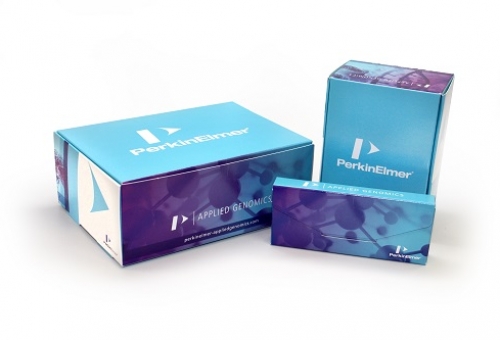
NEXTFLEX® RNA-Seq Barcodes
Up to 48 unique adapters available
Considerably reduce your per-sample sequencing cost by multiplexing libraries
Validated on Illumina® next-generation sequencing platforms
- Product description
- Kit Contents
- Citations
Added Flexibility to Library Preparation
The NEXTFLEX® RNA-Seq Barcodes are indexed adapters that are designed for use with the NEXTFLEX® Rapid RNA-Seq Kit and the NEXTFLEX® Rapid Directional RNA-Seq Kit. These barcodes are not recommended for use with the new NEXTFLEX® Rapid Directional RNA-seq kit 2.0.
These indexes are composed of a 6 nt error-correcting sequence, offering an improved multiplex workflow and adding flexibility to library prep. The ability to pool samples in an efficient way significantly decreases hands on time while providing robust data quality. Their automation-friendly format enables multiplexing of up to 48 samples. The NEXTFLEX® RNA-Seq Barcodes are available in sets of 6, 12, 24 and 48 unique adapters. We also offer the NEXTFLEX-96™ RNA-Seq Barcode Kits, which contain 96 – 8 nt index barcodes in a 96-well format (cat # NOVA-512915) .
Avoiding Registration Failure with Low Level Multiplexing
Registration failure could occur if the color balance was not maintained between the red and green lasers (used to sequence A/C bases and G/T bases, respectively). Read our blog post, Tech Tips – Barcode Recommendations for Low Level Multiplexing, to learn how to avoid registration failure on an Illumina® sequencer caused by lack of sufficient index sequence diversity.
Features
Indexed adapters compatible with Illumina® platforms for multiplexing libraries
Up to 48 unique adapters available
Considerably reduce your per-sample sequencing cost by multiplexing libraries
Increase your sequencing scale by pooling 100s of samples on a single flow cell
Validated on Illumina® next-generation sequencing platforms
Compatible with the NEXTFLEX® Rapid RNA-Seq Kit and the NEXTFLEX® Rapid Directional RNA-Seq Kit
Not compatible with the NEXTFLEX® Rapid Directional RNA-Seq Kit 2.0
Kit Specs
| Cat # | Name | Quantity |
| NOVA-512911 | NEXTFLEX® RNA-Seq Barcodes-6 | 48 RXNS |
| NOVA-512912 | NEXTFLEX® RNA-Seq Barcodes-12 | 96 RXNS |
| NOVA-512913 | NEXTFLEX® RNA-Seq Barcodes-24 | 192 RXNS |
| NOVA-512914 | NEXTFLEX® RNA-Seq Barcodes-48 | 384 RXNS |
| NOVA-512915 | NEXTFLEX® RNA-Seq Barcodes-96(in 96-well plate) | 768 RXNS |
KIT CONTENTS
NEXTFLEX® RNA-Seq Barcode Adapter (0.6 µM)
NEXTFLEX® Primer Mix (12.5 µM)
Selected Publications that Reference Using the NEXTFLEX® RNA Barcodes for Illumina® Multiplexing:
Baejen, C., Torkler, P., Gressel, S., Essig, K., Söding, J. and Cramer, P. (2014) Transcriptome Maps of mRNP Biogenesis Factors Define Pre-mRNA Recognition. Molecular Cell, 55: 5, 745–757.
Barske, L., et al. (2016) Competition between Jagged-Notch and Endothelin1 Signaling Selectively Restricts Cartilage Formation in the Zebrafish Upper Face. PLOS Genetics. doi: 10.1371/journal.pgen.1005967.
Beyaz, S. et al. (2016) High-fat diet enhances stemness and tumorigenicity of intestinal progenitors. Nature. 531, 53–58. doi:10.1038/nature17173.
Blance, S., et al. (2016) Stem cell function and stress response are controlled by protein synthesis. Stem cell function and stress response are controlled by protein synthesis. Nature, 534, 335–340. doi:10.1038/nature18282.
Bonizzoni, M., et al. (2013) Probing functional polymorphisms in the dengue vector, Aedes aegypti. BMC Genomics. 14:739 http://www.biomedcentral.com/1471-2164/14/739.
Boutrin, M.-C., et al. (2015) A putative TetR regulator is involved in Nitric Oxide stress resistance in Porphyromonas gingivalis. Molecular Oral Microbiology. doi: 10.1111/omi.12128.
Chen, L. et. Al. (2014) Transcriptional diversity during lineage commitment of human blood progenitors. Science 26: 345 (6204), 1251033 doi:10.1126/science.1251033.
Crocker, A., et al. (2016) Cell-Type-Specific Transcriptome Analysis in the Drosophila Mushroom Body Reveals Memory-Related Changes in Gene Expression. Cell Reports. doi: 10.1016/j.celrep.2016.04.046.
Denzler, R., Agarwal V., Stefano J., Bartel DP. and Stoffel, M. (2014) Assessing the ceRNA hypothesis with quantitative measurements of miRNA and target abundance. Mol. Cell. 54:4 pp 766-76.
Dharshinia, S., et al. (2016) De novo sequencing and transcriptome analysis of a low temperature tolerant Saccharum spontaneum clone IND 00-1037. J of Biotechnology. doi: 10.1016/j.jbiotec.2016.05.036.
Dobáková, E., Flegontov, P., Skalický, T. and Lukeš, J. (2015) Unexpectedly Streamlined Mitochondrial Genome of the Euglenozoan Euglena gracilis. Genome Biol Evol. 7. 3358-3367. doi:10.1093/gbe/evv229.
Fang, W. and Bartel, D. P. (2015) The Menu of Features that Define Primary MicroRNAs and Enable De Novo Design of MicroRNA Genes. Molecular Cell. 60:1. p131–145. doi: 10.1016/j.molcel.2015.08.015.
Guérin, F., Isnard, C., Cattoir, V. and Giard, J. C. (2015) Complex Regulation Pathways of AmpC-Mediated β-Lactam Resistance in Enterobacter cloacae Complex. Antimicrob. Agents Chemother., 59: 7753 – 7761. doi: 10.1128/AAC.01729-15.
Karamendina, K., et al. (2015) Complete Genome Sequence of Avian Paramyxovirus Strain APMV-6/red-crested pochard/Balkhash/5842/2013 from Kazakhstan. Genome Announc. 3:4, e00158-15.
Lamanna, F., et al. (2015) Cross-tissue and cross-species analysis of gene expression in skeletal muscle and electric organ of African weakly-electric fish (Teleostei; Mormyridae). BMC Genomics. 16:668 . doi:10.1186/s12864-015-1858-9.
Lin, M.-H., Jones, D. F. and Fleming, R. (2015) Transcriptomic analysis of degraded forensic body fluids, Forensic Science International: Genetics, Volume 17. 35-42. dio: 10.1016/j.fsigen.2015.03.005.
Mullenders, J., et al. (2015) Cohesin loss alters adult hematopoietic stem cell homeostasis, leading to myeloproliferative neoplasms. J. Exp. Med. 2015; 212:1833-1850. doi: 10.1084/jem.20151323.
Nam, J., Rissland, O.S., Koppstein, D. et al. (2014) Global Analyses of the Effect of Different Cellular Contexts on MicroRNA Targeting. Molecular Cell. http://dx.doi.org/10.1016/j.molcel.2014.02.013.
Páneka, T., et al. (2016) First multigene analysis of Archamoebae (Amoebozoa: Conosa) robustly reveals its phylogeny and shows that Entamoebidae represents a deep lineage of the group. Molecular Phylogenetics and Evolution. doi:10.1016/j.ympev.2016.01.011.
Pham, K. T. M., et al. (2015) MoSET1 (Histone H3K4 Methyltransferase in Magnaporthe oryzae) Regulates Global Gene Expression during Infection-Related Morphogenesis. PLOS Genetics. doi: 10.1371/journal.pgen.1005385.
Rossetto CC, Tarrant-Elorza M, Pari GS (2013) Cis and Trans Acting Factors Involved in Human Cytomegalovirus Experimental and Natural Latent Infection of CD14 (+) Monocytes and CD34 (+) Cells. PLoS Pathog 9(5): e1003366. doi:10.1371/journal.ppat.1003366.
Rube, H. T., et al. (2016) Sequence features accurately predict genome-wide MeCP2 binding in vivo. Nature Communications. 7:11025. doi:10.1038/ncomms11025.
Tan, M. H., et al. (2015) First comprehensive multi-tissue transcriptome of Cherax quadricarinatus (Decapoda: Parastacidae) reveals unexpected diversity of endogenous cellulose. Organisms Diversity & Evolution. Pg 1 – 16. Doi: 10.1007/s13127-015-0237-3.
Tarvin, R. D., Santos, J. C., O’Connell, L. A., Zakon, H. H. and Cannatella, D. C. (2016) Convergent Substitutions in a Sodium Channel Suggest Multiple Origins of Toxin Resistance in Poison Frogs. Mol Biol Evol. 33:4. 1068-1081. doi: 10.1093/molbev/msv350.
Tomida, J. et. al. (2015) REV7 is essential for DNA damage tolerance via two REV3L binding sites in mammalian DNA polymerase. Nucl. Acids Res. doi: 10.1093/nar/gku1385.
Van Campenhout, J., Vanreusel, A., Van Belleghem, S. and Derycke, S. (2016) Transcription, Signaling Receptor Activity, Oxidative Phosphorylation, and Fatty Acid Metabolism Mediate the Presence of Closely Related Species in Distinct Intertidal and Cold-Seep Habitats. Genome Biol Evol, 8: 51 – 69. doi: 10.1093/gbe/evv242.
Van Laar, T, A., Chen, T, You, T., and Leung, K. P. (2015) Sublethal Concentrations of Carbapenems Alter Cell Morphology and Genomic Expression of Klebsiella pneumoniae Biofilms. Antimicrobial Agents and Chemotherapy. doi: 10.1128/AAC.04581-14.
Wheeler, M. M. and Robinson G. E. (2014) Diet-dependent gene expression in honey bees: honey vs. sucrose or high fructose corn syrup. Scientific Reports. 4: 5726. doi:10.1038/srep05726.
Zhang, Y. et al. (2015) Genome-, Transcriptome- and Proteome-Wide Analyses of the Gliadin Gene Families in Triticum urartu. PLOS One. doi: 10.1371/journal.pone.0131559.








